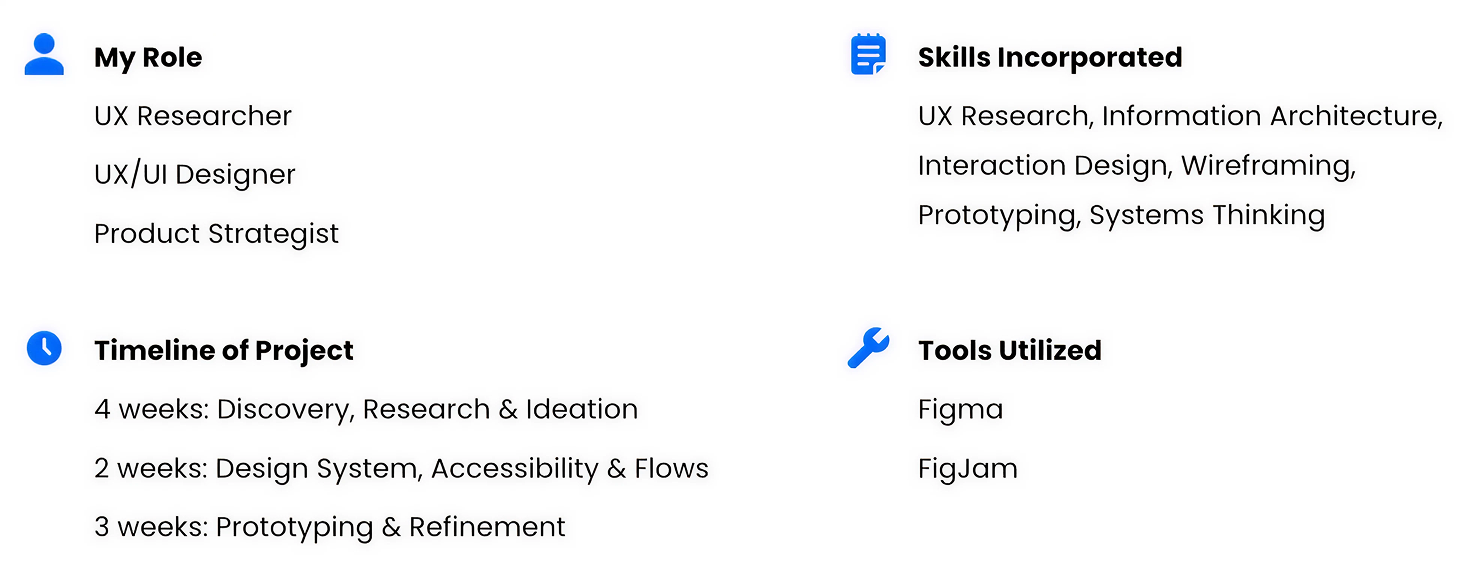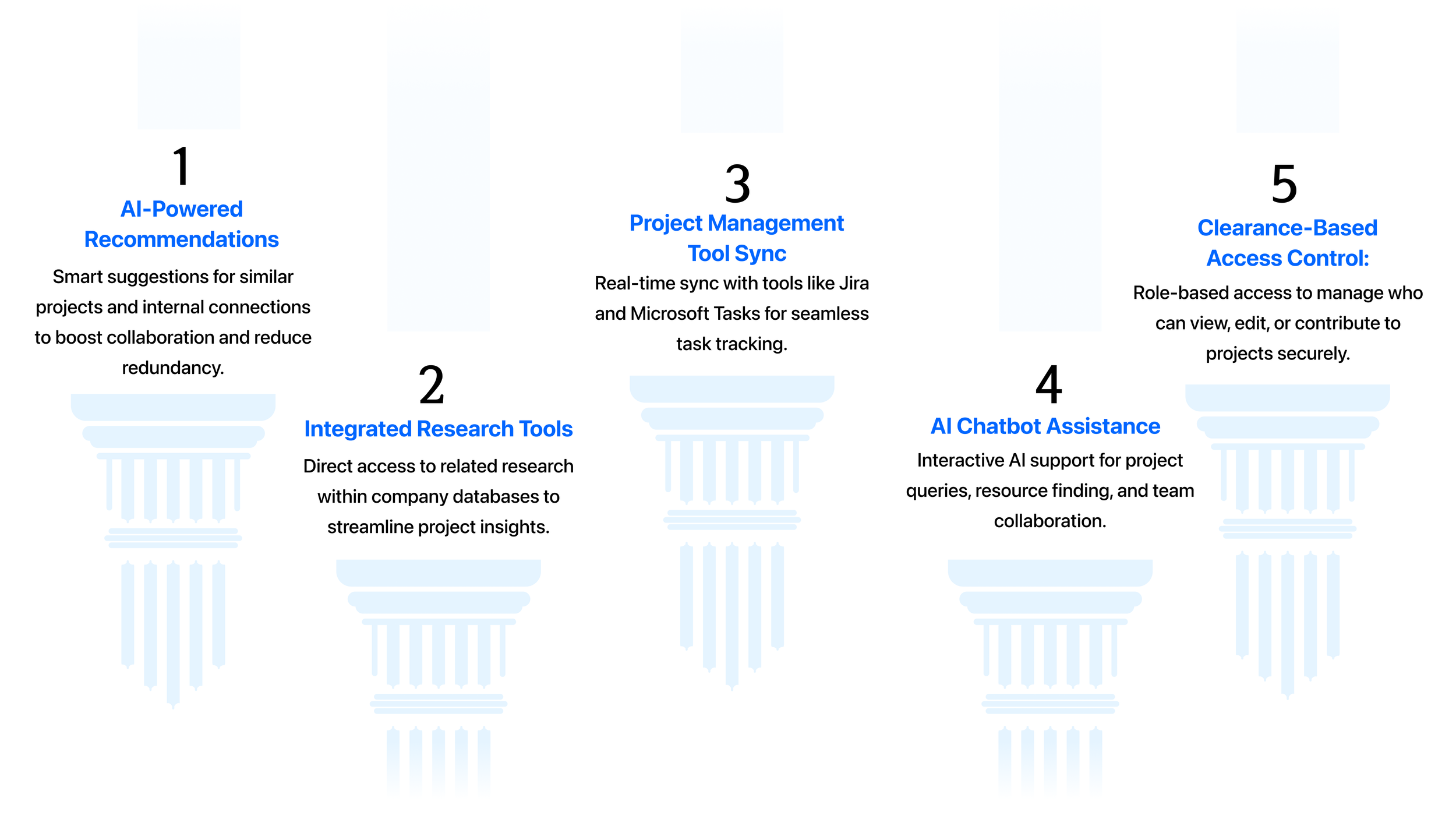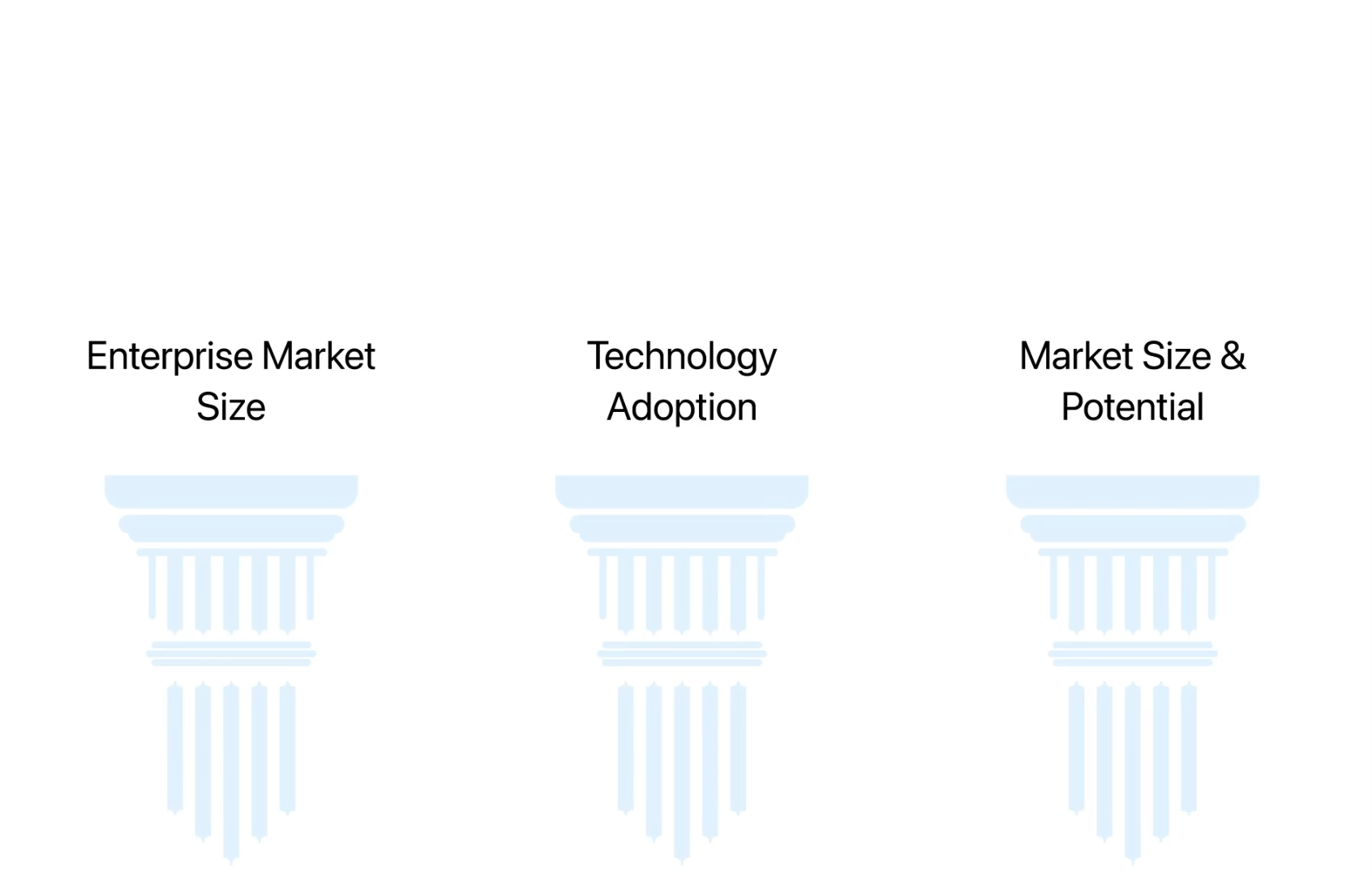
Overview
This project originated from patterns I noticed across previous work experiences, where I encountered firsthand the challenges of project knowledge sharing within organizations. Motivated by these observations, I conducted independent research to explore potential solutions and later developed and designed the interface in a UX Design Studio course (INST454), transforming my findings into a functional product concept.
Project highlights and responsibilities overview
The Problem
Managing projects in large companies requires extensive cross-functional collaboration, but valuable resources often go unnoticed, leading to missed opportunities for alignment and innovation.
Understanding the Problem
Discovering pain points users face through empathy and research
Through early secondary research and peer discussions, I uncovered recurring frustrations around knowledge silos, poor information visibility, and inefficient cross-team communication. These insights framed the foundation for defining HiveMind’s purpose and user direction.
User Persona
I developed this persona based on secondary research and peer insights to better understand the needs of enterprise professionals. Drawing from discussions on platforms like Reddit, workplace forums, and conversations with peers in product and research roles, this persona captures common pain points around information sharing, workflow inefficiencies, and cross-team collaboration. These insights informed my design decisions and helped ensure that HiveMind’s solution aligns with real-world enterprise challenges.
Developing a Solution
After identifying key challenges, I transitioned into defining a solution that addressed these collaboration gaps through structured research, competitive analysis, and feature prioritization.
Competitive Analysis
To ground my research in the current landscape, I analyzed how existing solutions handle team collaboration, project visibility, and information access. This clarified market limitations and opportunities within the enterprise project management space.
Final Solution
A centralized project database for large companies, allowing teams to upload, share, and manage projects across branches with clearance-based access. AI suggests relevant projects, recommends internal connections, and integrates with research databases for seamless searches and insights
Core Features
From my research and early concept exploration, I identified key features that would best address users’ needs for accessibility, efficiency, and collaboration across enterprise teams.
SWOT Analysis
To evaluate the feasibility and impact of these features, I conducted a SWOT analysis to assess HiveMind’s potential strengths, limitations, and opportunities within the enterprise project management space.
Logic Framework Matrix
After assessing HiveMind’s strengths, weaknesses, opportunities, and threats, I wanted to ensure the concept was both strategic and measurable. I created a Logic Framework Matrix to define clear objectives, indicators, and assumptions that translate HiveMind’s goals into actionable outcomes.
User Flow
To translate research insights into action, I designed user flows that illustrate how teams could interact with HiveMind’s core features. These flows helped me confirm that each feature followed a logical sequence before translating ideas into low-fidelity designs.
Key:
Dashboard: As a user, I want a unified dashboard that shows my upcoming tasks from different project tools in one place, personalized AI-generated suggestions based on my recent activity, and quick access to recent projects and relevant teammates; along with a floating AI chat assistant for asking quick questions all so I can stay organized and act efficiently.
Ai Chatbot Page: As a user, I want to interact with an AI chatbot that can help me determine whether similar projects already exist, assist with research-related questions, and refine search queries, so I can avoid duplicating work and easily locate relevant resources within the organization.
AI-Integrated Research and Project Search Engine: As a user, I want to use AI to search across my company’s research databases and past projects, even without exact keywords. This helps me find relevant files, reuse templates or best practices, and avoid redundant work while filtering by department or role, identifying contributors, and viewing access permissions.
Personal Page: As a user, I want a personal page that shows an overview of all the projects I’m currently working on, my starred documents, and ways to create research or project documents for the database.
Designing & Iterating
Defining HiveMind’s visual identity and translating its core concept into cohesive high-fidelity designs.
Design System
I built a modular design system defining typography, color, iconography, and component standards across light and dark themes. Each element was designed for accessibility, consistency, and scalability within HiveMind’s interface.
Low Fidelity Wireframes
Mid Fidelity Wireframes
Final Prototype
Considerations
These considerations were integral throughout HiveMind’s research and design process, ensuring the product remained accessible, cohesive, and strategically viable from concept to completion.
Design Considerations
Light & Dark Mode Exploration
To ensure consistency and accessibility, I designed HiveMind’s interface and responsive design system to adapt seamlessly across light and dark modes.
*This fine-tuned process stretched my design capabilities, challenging me to balance aesthetics, usability, and system cohesion.
Strategic Considerations
Market Opportunity & Product Viability
To ensure HiveMind’s concept was not only user-centered but also strategically sound, I assessed its market opportunity and product feasibility.
By analyzing enterprise AI adoption trends and collaboration tool growth, I found clear potential for HiveMind to scale within the emerging landscape of intelligent project management solutions.
Reflection
Working on HiveMind was a defining experience that strengthened my ability to bridge design, research, and strategy. It challenged me to think critically about accessibility, scalability, and feasibility—skills that helped me evolve from simply designing interfaces to building thoughtful, real-world systems.
Key learnings and takeaways:
Developed a comprehensive design system that emphasized modularity and visual consistency.
Conducted accessibility checks to ensure inclusive experiences across all interface states.
Learned and applied new tools such as Jitter to incorporate motion and dynamic interaction into prototypes.
Drew on insights from previous work experiences to ground new ideas in technical feasibility and real-world limitations and potential.
Thank You!
Please check out my other Projects!

















